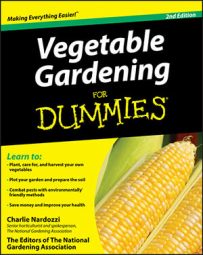Take the right approach to watering garden vegetables to maximize crop production. In general, most vegetable plants use about 1 inch of water per week (1 to 2 inches in hot, windy, dry climates). If you don’t get water from rainfall, you have to supply it. Here are some general guidelines for determining when your plants need water:
Your finger is the best indicator of when the soil has dried sufficiently to rewater: Dig down several inches into the soil; if the soil is dry to your touch 3 to 4 inches down, it’s time to water.
Wilting plants can be a sign that your soil needs water: Wilting is when the leaves or stems of a plant droop, bend over, and look limp. These symptoms, however, can be misleading at times. Some plants, like tomatoes, peppers, and eggplants, tend to droop slightly during the heat of the day, even if the soil has enough moisture. If your plants don’t stand tall and proud and the soil feels dry, add water and watch them perk up fast.
Overwatering also causes plants to wilt, so check the soil before watering. If the soil is waterlogged, roots die from lack of air. With fewer roots, plants can no longer take up the water they need from the soil, and so they wilt. Damage from insects and disease also cause wilting.
Each vegetable has a critical period when you need to be especially careful about watering: If you slack off during these times, your crop may be ruined. The following table shows the important watering periods for different types of vegetables.
| Vegetable | Important Watering Stage |
|---|---|
| Bean, lima | When flowering and forming pods |
| Bean, snap | When flowering and forming pods |
| Broccoli | When forming a head |
| Brussels sprouts | When forming sprouts |
| Cabbage | When forming a head |
| Carrots | When forming roots |
| Cauliflower | When forming a head |
| Corn, sweet | When silking, tasseling, and forming ears |
| Cucumber | When flowering and developing fruit |
| Eggplant | Give uniform supply of water from flowering through harvest |
| Lettuce | When true leaves form |
| Melon | During fruit set and early development |
| Onion, dry | During bulb enlargement |
| Pea | When flowering and during seed enlargement |
| Pepper | Give uniform supply of water from flowering through harvest |
| Potato | When tubers set and enlarge |
| Pumpkin | When fruits form |
| Radish | When forming roots |
| Spinach | When true leaves form |
| Squash, summer | When forming buds and flowering |
| Swiss chard | When true leaves form |
| Tomato | Give uniform supply of water from flowering through harvest |
| Turnip | When forming roots |

